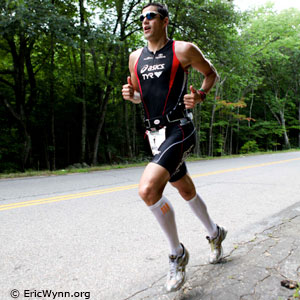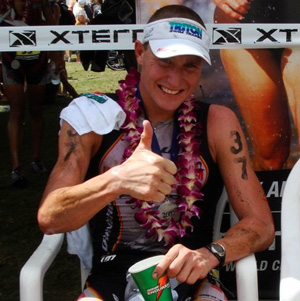Chris Legh returns
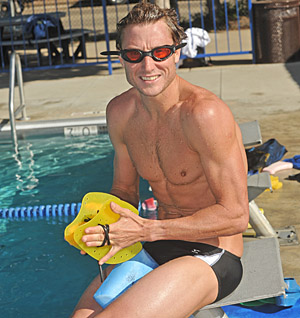
Chris Legh made one of the sport’s great comebacks when he recovered from a dehydration-induced bowel shutdown at Ironman Hawaii in 1997. After surgeons cut out 12 inches of his colon, Legh was back the very next year in an epic duel with Peter Reid at Ironman Australia, losing a finish line sprint. Legh also engaged Reid in another classic duel at Ironman Australia the very next year, and turned the trick at to win Ironman California in 2000.
Things went well for one of the most talented men in the sport until 2003, when Legh faced a second showdown with his body. Racing exposed a congenital defect – a tiny hole in the wall of his heart — which struck around the 5 hour mark of a triathlon. After carefully adapting his hydration and nutrition, Legh managed to finesse his way around the problem with an amazing win at Ironman Coeur d’Alene in 2004 — headlined by a famous Gatorade ad. But this second comeback was not to last. For the next two years, the syndrome shut him down like clockwork at 120km into an Ironman bike.
Finally, the new Ironman 70.3 series provided a proper competitive outlet for one of the most talented men in triathlon history. In three years, Legh scored nine Ironman 70.3 wins. The only thing lacking was a podium solution for the Ironman 70.3 World Championship at Clearwater. Legh got a 4th there and was coming closer in training to the strategy – until he was faced with a third medical challenge late last year. An inflamed area around his pubic bone put one of the swiftest legs in the game out of action for eight months.
A week ago, Legh faced his first test in eight months at the Timberman 70.3. His 5th place finish was not to his standards – 10 minutes 34 seconds behind Andy Potts. His swim was 5 minutes back of Potts. His 2:12:45 bike was better, 2:40 behind Potts. And his run, usually his ace in the hole but now the most susceptible to his injury, was a third-best 1:19:10, 3 minutes behind Potts.
Given he had only had six weeks of training, not a bad start to another comeback. Legh spoke to Slowtwitch as he was planning the rest of his 2009 campaign.
Slowtwitch: What did you think about your first hit out in quite a while?
Chris Legh: I forget how much they hurt. I think it was a little rough on my expectations. It was a long break. I think I wanted to go a little better than that. What was missing was just the high end.
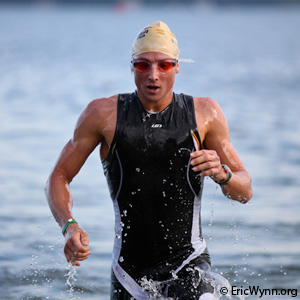
ST: How did the race start?
Chris: There was a delay at the swim start. There was an accident on the road, so they had to take police away from the intersections and we had to wait to get the police back for the race. We had to be ready to go at first light and so we all had no warm-up for the swim — and I got dropped on the swim.
ST: You lost five minutes to Potts. Worse than usual. What about the bike?
Chris: I knew it would be a strength day. I raced really well early on the bike. I could see Michael Lovato ahead in 3rd or 4th. But halfway through the bike I started to lose it. I consciously wanted to go, but I knew I had to hold back to finish the run. After that, I had no aggression.
ST: How did you keep it going? You didn’t want to travel 2,000 miles to drop out.
Chris: My tactic after the bike was to break the run into quarters. It was two laps out and back. By the time I hit the final turnaround I had Michael Lovato and Bjorn Andersson in sight. It worked out well enough, but I had no high end there either. Still, it was a bit of fun when I started to catch Bjorn with half a mile to go. (Andersson outbiked Legh by 8 minutes, Legh outran Andersson by 11 minutes and beat him overall by 39 seconds). Michael looked around and gave me a grin near the end when he realized I was out of real estate. They are good guys to race and by the time I hit the finish line, Michael was still ahead and laughed at me. (Legh outran Lovato 1:19:10 to 1:21:45 but Lovato held him off for 4th place by 24 seconds) It was a good day.
ST: When did things start to go bad for you – again?
Chris: Eight months ago. Back in November I only had one race left and I was training for Thailand when I got a really sharp abdominal pain in one area. I got through the race at Laguna Phuket, but it wasn't true sport. I was just surviving.
ST: Was this another medical mystery?
Chris: We couldn’t pinpoint where the pain came from right away. But scans back home in Australia found it was osteoitis pubi. That is, a joint at the pelvic bone had become inflamed and had become unstable. It is really common with Australian rules football and soccer players.
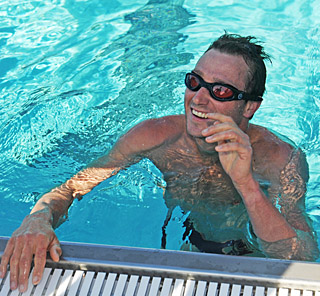
ST: Back in Melbourne you had a good set of medical expertise available?
Chris: When I got home it was great. We had access to a lot of sports medicine specialists who deal with Aussie rules pro footballers.
ST: What did they prescribe?
Chris: Initially, it was rest. I had to get the inflammation down. I could walk to the super market but not for exercise. I had to stay still, not play in garden, no golf, no surfing. It was really annoying. When you want to take a break, you’d like to enjoy yourself.
ST: Most outsiders think of east coast – Sydney, Gold Coast, Noosa – and west coast – Perth – for surfing. Where’s the breaks near Melbourne, mid-country, in the south?
Chris: The Mornington Peninsula near Melbourne faces Tasmania. They get good waves.
ST: What did you do when you were out of action?
Chris: I did a little work with WTC, did some stuff with Gatorade and a little with Bolle.
Chris: I had to get inflammation down in the joints and work out why it had come around. So I did a lot of pelvic floor stability exercises, which strengthen the pelvic girdle. That tightens the pelvic bone again and take pressure off. When the inflammation hits, there are a lot of stresses to the adductors and glutes, which try to compensate and pull one half of the pelvis tighter. At the end of the day, we worked out what was causing the problem, got the inflammation down, and strengthened the pelvis with exercises in flexibility and massage.
ST: This took a while. It must have been stressful to see your 2009 season shrink before it could get started?
Chris: I had a calendar of races set up. But one by one I had to tick them off. So, when the pain receded enough to train, it was time to travel back to our home in Lyons near Boulder. My goal was to land here and had no pain. We got to Boulder in late June and probably had now a six weeks of training before Timberman.
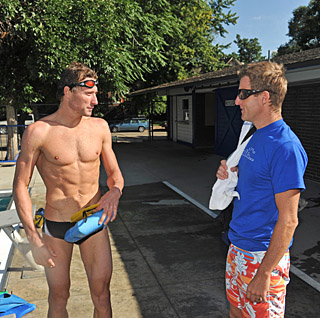
ST How well are you covered for medical care in Australia?
Chris: In Australia we have had insurance through our professional triathlon license. The fee went up from $50 or $60 to $500, but that was purely for insurance. It happened in one fell swoop and everyone had to deal with that — even pros racing overseas didn’t enjoy paying that high a fee. But it covers us for medical care throughout the world. Then, in Australia we have Medicare for everyone, like Canada. But unlike Canada, we also have access to private insurance. In Australia, if you are uninsured you are covered for emergency surgeries. But if you have private insurance on top of Medicare, you can have more specialists. So I could see sports medicine specialists two or three times a week. The private insurance costs about $300 a month for a family.
The bottom line is when you are seeing people three or four times a week and having MRIs and scans, there are a little out of pocket expenses. But you know you are going to be looked after and they will not send you home broke.
ST: Did you have to proceed gingerly your first days back in training?
Chris: Before I started training again I had to take two weeks to get ready to train. In a sense I had to have a training camp to be ready for training camp. So I got through that. But I was still quite a bit behind. Leading into Timberman, I have done two hard bike sessions and three hard runs. Still, I was a little disappointed.
ST: How do you evaluate your performance in Timberman? How did you feel physically afterward?
Chris: Physically, in regard to my injury, great. I thought I’d wake up the next day and have a little discomfort. But there was absolutely nothing. I did not have the usual rhythm and was not smooth on the run the way I am used to when I’m fit. It was a bit of an effort. The bike felt great early on, then I had to scale back. I thought it was going to come around, but I suffered the second half.
ST: Well, Timberman has some hills on the run. And no one set the run on fire.
Chris: No one put together a great run. Andy Potts was the fastest runner at 1:16:20.
ST: When you are on, that’s giving you two or three minutes? Instead you had the third fastest run and were 3 minutes slower than Potts.
Chris: When Andy has the fastest run with a 1:16 — he runs really well – that indicates it was a pretty tough day out there. The run course was very hilly and very testing. The run is up and down and it was humid.
ST: You overcame a lot to get in shape to win Ironman Coeur d’Alene in 2004. But ultimately your hole in the heart wall forced you to focus on the 70.3 series. For two years, 2006 and 2007, you had a lot of wins there. What was your 2008 season like?
Chris: Not bad. I won three times last year, including Steelhead and Cancun 70.3s, and I took third at Eagleman 70.3 and Lake Stevens 70.3. I thought things were coming around after Cancun, but everything crumbled in September. At the end of the season it was frustrating. I had a little flu at InterBike just before Xterra Tahoe and took 7th. I had absolutely nothing. At Xterra Maui I struggled to 10th. I shouldn’t even have started at Clearwater (Ironman 70.3 Worlds) but by that time I thought it was worth an attempt. I was definitely underdone for that. I was sick and did absolutely no training.
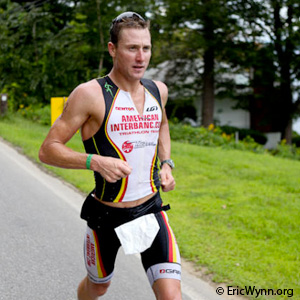
ST: With all your struggles to recover from the 1997 ishemic bowel injury at Ironman Hawaii, then encountering the hole in the heart which ended your Ironman quest in 2006, was the birth and rapid growth of the Ironman 70.3 series a godsend?
Chris: For me 70.3 was perfect timing. It gave me a place to go to walk away from Ironman. The truth is I never really loved the distance because I never really got close to my potential (despite winning Ironman California in 2000 and contesting two of the sport’s greatest duels with Peter Reid at Ironman Australia in 1998 and 1999). So it would have been a shame if the Ironman 70.3 series was not there to fall back on. It was ideal because we could finish many more races at that distance in a season and there became so much more emphasis on participation in 70.3s. It was perfect. It was a great name, a great vehicle for us to get exposure.
ST: In some ways, you’ve been fantastic in overcoming so many obstacles in triathlon. But it must be hard on you to face a third major obstacle like this?
Chris: It was a fun challenge to come back from the 1997 incident. Then starting in 2003, it was the hole in the heart — patent foreamen ovale. When you are in the womb, there is a hole in the wall of the heart which allows blood to flow back and forth. In a normal person, when you grow into adulthood, the hole closes up. But in a relatively large percentage of the population, close to 20 percent, it is not uncommon under the stress of something like triathlon training and racing that the hole will be revealed again. It gets to the point of electrolyte imbalance when greater blood pressure puts it under stress. At the end of a tough day, it results in pulmonary edema, a fluid buildup. It popped up in 2003 in Canada, and then continued through to my last Ironman in Australia in 2006. By then, every single time I thought I was better and tried to race an Ironman, I was finished after 120km on the bike. I just could not be competitive after that point.
ST: How successful have you been at the 70.3 distance?
Chris: I think I have won nine 70.3 races.
ST: With the ITU bringing out a season-long World Championship Series of races, isn’t it time that the Ironman 70.3 create a points series? Unlike the full Ironman distance, top pros could do half a dozen a year.
Chris: Right now they call it a series, but a series does not exist. Right now they have a catalogue of races. But if someone approaches the WTC with a right idea, it should work. I think they should have a series of points races in major regions of the world and have the best show up for worlds. I think they might require competitors from each region to race three and then have more points at a regional final and double points at Worlds. You might start with Pacific (Australia, New Zealand, Japan, Korea and China) North and South America, and Europe. All of the top pros have the capacity to race five or six of these in the year plus a world championships.
ST: Where will you race next?
Chris: I planned to race Muskoka 70.3 in a few weeks, but I may cancel that and put in five weeks of good training and do Augusta 70.3. I’ve already qualified for Clearwater at Timberman. This will give me a chance to put five weeks in before Augusta and then another month before Maui. Normally, racing gets me fully prepared for the big races.
ST: Can you be competitive for Clearwater?
Chris: Yes. I’ve raced it three times now and I have seen what that race is all about and what it takes. It is funny. Even though it is flat and boring, the course takes a lot of strength on the bike. It will take a very good swim for me to stay in the game. Then I know I can come with the lead pack on the bike. Then it comes down to a sub-1:12 run. I like to think I can execute the plan over the next three months. I know I raced Clearwater three times now. I know what it takes. It is almost a specialized distance now. A lot of short course guys are stepping up. It suits guys with lot of speed.
ST: Can you pull it all together in 10 weeks?
Chris: Since last year, I've gotta find a minute or so on the run. Normally, I do a lot of racing and it sets me up well. Now I am getting a little too tired for racing as often as I did in the past.
ST: Australian triathletes are renowned for their hard work ethic and doing what they call the hard yards. Yet of all the great ones that have emerged in the third of a century, many of the best have been sidelined by physical ailments similar to yours. Greg Welch and Emma Carney both suffered life-threatening ventricular tachycardia that cut their careers short. Bruce Thomas had a similar heart-related syndrome that ended his career. And you certainly have faced more than your share of problems. What do you think may be the cause?
Chris:That is one positive about our sport. Even if you start off a little slow in the early years, you can get increased performance in response to training and hard work. The negative is that when you put in years of hard training, it does take its toll. This will be the first generation of elite world class athletes who have gone through this kind of volume and intensity of training. And when it is all analyzed, we will probably see that it has not been all that healthy for us. But then we also learn from it. We are all speaking to a lot of athletes, guys and girls. And you know you have to train hard, but likely it was not necessary to do the volume of the first generation.


